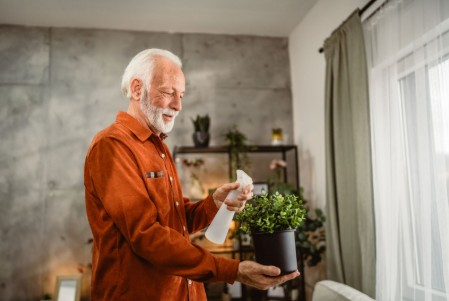Rooting for You: A Guide to Thriving Indoor Plants at Monroe Village
March 7, 2025
Bringing nature indoors is one of the best ways to create a refreshing, inviting, and vibrant atmosphere. Indoor plants not only enhance the aesthetics of your home but also contribute to improved air quality and overall well-being. Whether you are an experienced plant parent or just starting your indoor gardening journey, knowing how to properly care for your plants is essential. This guide will provide you with practical tips to help your indoor plants thrive within your Monroe Village home.
Why Indoor Plants Are Beneficial
Indoor plants do more than just add beauty to a space; they offer a wide range of benefits that can improve both physical and mental health. Studies have shown that being around greenery can reduce stress, boost mood, and even enhance productivity. Here are some of the many advantages of incorporating plants into your living space:
1. Improved Air Quality
Many indoor plants act as natural air purifiers by filtering out harmful toxins and releasing oxygen. Some top air-purifying plants include the snake plant, peace lily, and spider plant.
2. Mood-Boosting Effects
Living among greenery has been linked to lower stress levels and increased happiness. Plants create a calming environment that promotes relaxation and mental clarity.
3. Noise Reduction
Plants can help absorb sound, making your home feel quieter and more serene. This can be particularly beneficial in busy areas or communal living spaces.
4. Humidity Control
By releasing moisture into the air, indoor plants can help maintain a balanced humidity level, which is beneficial for respiratory health and can prevent dry skin during colder months.
5. Enhancing Home Decor
Plants elevate interior design, adding texture, color, and vibrancy to any space. Whether you prefer a minimalist aesthetic or a jungle-like atmosphere, there’s a plant that fits your style.
Choosing the Right Indoor Plants
Not all plants thrive indoors, so selecting the right varieties is essential for long-term success. Here are some of the best indoor plants that require minimal maintenance and thrive in various indoor conditions:
- Snake Plant (Sansevieria) – Extremely resilient and can survive in low light with minimal watering.
- Pothos (Epipremnum aureum) – A fast-growing vine that adapts well to different lighting conditions.
- Peace Lily (Spathiphyllum) – A beautiful plant that purifies air and requires moderate care.
- Spider Plant (Chlorophytum comosum) – Low-maintenance and excellent for improving air quality.
- ZZ Plant (Zamioculcas zamiifolia) – Can survive in low light with very little water, making it nearly indestructible.
- Aloe Vera – Not only an attractive plant, but it also provides soothing gel for minor burns and skin care.
- Fiddle Leaf Fig (Ficus lyrata) – A trendy plant that adds a bold, stylish touch to any room.
- Chinese Evergreen (Aglaonema) – A perfect option for low-light environments, available in various colors.
Essential Indoor Plant Care Tips
To ensure that your indoor plants remain healthy and vibrant, follow these essential care tips:
1. Provide the Right Amount of Light
Each plant has unique light requirements. Some thrive in bright, indirect sunlight, while others prefer low-light conditions. Place plants near windows with filtered light or use grow lights for additional support. If leaves turn yellow, it may be a sign of too much sunlight, whereas drooping leaves could indicate insufficient light.
2. Water Wisely
Overwatering is one of the most common mistakes plant owners make. As a general rule, water when the top inch of soil feels dry. Use pots with drainage holes to prevent root rot. In winter, most plants require less frequent watering, so adjust accordingly.
3. Maintain Proper Humidity Levels
Indoor environments, especially during winter, can become dry. To maintain proper humidity levels, consider misting plants, using a humidity tray, or placing a humidifier nearby. Grouping plants together can also help increase moisture levels.
4. Feed Your Plants
Plants need nutrients just like people do. Use a balanced liquid fertilizer every few weeks during the growing season to provide essential nutrients. Slow-release fertilizers are also an option for long-term nourishment.
5. Repot When Necessary
Over time, plants outgrow their containers. Repotting helps refresh the soil, provides more space for root development, and prevents plants from becoming root-bound. Signs that a plant needs repotting include roots growing out of the drainage holes, stunted growth, and soil drying out quickly.
6. Keep an Eye on Pests
Common indoor plant pests include spider mites, mealybugs, and aphids. Inspect your plants regularly, and if you notice any pests, wipe the leaves with a mild soap solution or use insecticidal soap. Keeping plant leaves clean by occasionally wiping them with a damp cloth can help prevent pest infestations.
Creating a Thriving Indoor Oasis at Monroe Village
By following these simple care tips, you can create a lush and vibrant indoor garden that enhances your home and overall well-being. At Monroe Village, we understand the importance of creating a peaceful and green living environment, which is why our community is designed to support and encourage plant-friendly living. Our community offers opportunities for residents to learn, grow, and cultivate beautiful indoor and outdoor gardens. Schedule a tour today and check it out yourself!
Explore more about life at Monroe Village by visiting our Community Overview.




